Polyphenolic Compounds from Lespedeza Bicolor Root Bark Inhibit Progression of Human Prostate Cancer Cells via Induction of Apoptosis and Cell Cycle Arrest
Abstract
1. Introduction
2. Materials and Methods
2.1. General Experimental Procedures
2.2. Plant Material
2.3. Analytical and Preparative HPLC
2.4. HR-ESI-MS
2.5. Extraction and Isolation
2.5.1. (6aR,11aR)-8-O-Methyl-6a,11a-Dihydrolespedezol A2 (7)
2.5.2. Lespebicolin A (8)
2.6. Cell Lines and Conditions
2.7. MTT Assay
2.8. Flow Cytometry Analysis
2.9. Quantitative Real-Time PCR (qPCR)
3. Results and Discussion
3.1. Isolation and Structure Elucidation of Compounds 1–8
3.2. Investigation of Anticancer In Vitro Activity of the Compounds 1–8
4. Conclusions
Supplementary Materials
Author Contributions
Funding
Conflicts of Interest
References
- Sun, H.; Lei, Y.N.; Deng, W.; Wang, H.M.; Teng, Y.O.; Zhao, H.Y.; Yao, Q.W.; Yu, P. First Total Synthesis and Cytotoxicity of Naturally Occurring Lespedezol E1. Chem. Nat. Compd. 2016, 52, 896–898. [Google Scholar] [CrossRef]
- Woo, H.S.; Kim, D.W.; Curtis-Long, M.J.; Lee, B.W.; Lee, J.H.; Kim, J.Y.; Kang, J.E.; Park, K.H. Potent inhibition of bacterial neuraminidase activity by pterocarpans isolated from the roots of Lespedeza bicolor. Bioorg. Med. Chem. Lett. 2011, 21, 6100–6103. [Google Scholar] [CrossRef] [PubMed]
- Maximov, O.B.; Kulesh, N.I.; Stepanenko, L.S.; Dmitrenok, P.S. New prenylated isoflavanones and other constituents of Lespedeza bicolor. Fitoterapia 2004, 75, 96–98. [Google Scholar] [CrossRef] [PubMed]
- Glyzin, V.I.; Ban’kovskii, A.I.; Zhurba, O.V.; Sheichenko, V.I. Flavonoids of Lespedeza bicolor. Chem. Nat. Compd. 1970, 6, 487–488. [Google Scholar] [CrossRef]
- Jae-Hak, T.A.L.; Jin-Woo, T.A.J. Antioxidant activity of different parts of Lespedeza bicolor and isolation of antioxidant compound. Korean J. Food Sci. Technol. 2012, 44, 763–771. [Google Scholar]
- Do, M.H.; Lee, J.H.; Wahedi, H.M.; Pak, C.; Lee, C.H.; Yeo, E.J.; Lim, Y.; Ha, S.K.; Choi, I.; Kim, S.Y. Lespedeza bicolor ameliorates endothelial dysfunction induced by methylglyoxal glucotoxicity. Phytomedicine 2017, 36, 26–36. [Google Scholar] [CrossRef] [PubMed]
- Lee, Y.-S.; Chang, Z.; Park, S.-C.; Rim, N.-R.; Kim, N.-W. Antioxidative activity and irritation response of Lespedeza bicolor. Toxicol. Res. 2005, 21, 115–119. [Google Scholar]
- Lee, S.J.; Hossaine, M.D.; Park, S.C. A potential anti-inflammation activity and depigmentation effect of Lespedeza bicolor extract and its fractions. Saudi J. Biol. Sci. 2016, 23, 9–14. [Google Scholar] [CrossRef]
- Ko, Y.H.; Shim, K.Y.; Kim, S.K.; Seo, J.Y.; Lee, B.R.; Hur, K.H.; Kim, Y.J.; Kim, S.E.; Do, M.H.; Parveen, A.; et al. Lespedeza bicolor Extract Improves Amyloid Beta25–35-Induced Memory Impairments by Upregulating BDNF and Activating Akt, ERK, and CREB Signaling in Mice. Planta Med. 2019, 85, 1363–1373. [Google Scholar] [CrossRef]
- Do, M.H.; Lee, J.H.; Cho, K.; Kang, M.C.; Subedi, L.; Parveen, A.; Kim, S.Y. Therapeutic Potential of Lespedeza bicolor to Prevent Methylglyoxal-Induced Glucotoxicity in Familiar Diabetic Nephropathy. J. Clin. Med. 2019, 8, 1138. [Google Scholar] [CrossRef]
- Kim, Y.; Lee, H.; Kim, S.Y.; Lim, Y. Effects of Lespedeza Bicolor Extract on Regulation of AMPK Associated Hepatic Lipid Metabolism in Type 2 Diabetic Mice. Antioxidants 2019, 8, 599. [Google Scholar] [CrossRef] [PubMed]
- Ullah, S. Methanolic extract from Lespedeza bicolor: Potential candidates for natural antioxidant and anticancer agent. J. Tradit. Chin. Med. 2017, 37, 444–451. [Google Scholar] [CrossRef]
- Tarbeeva, D.V.; Fedoreyev, S.A.; Veselova, M.V.; Blagodatski, A.S.; Klimenko, A.M.; Kalinovskiy, A.I.; Grigorchuk, V.P.; Berdyshev, D.V.; Gorovoy, P.G. Cytotoxic polyphenolic compounds from Lespedeza bicolor stem bark. Fitoterapia 2019, 135, 64–72. [Google Scholar] [CrossRef] [PubMed]
- Thuy, N.T.T.; Lee, J.E.; Yoo, H.M.; Cho, N. Antiproliferative Pterocarpans and Coumestans from Lespedeza bicolor. J. Nat. Prod. 2019, 82, 3025–3032. [Google Scholar] [CrossRef]
- Dyshlovoy, S.A.; Tabakmakher, K.M.; Hauschild, J.; Shchekaleva, R.K.; Otte, K.; Guzii, A.G.; Makarieva, T.N.; Kudryashova, E.K.; Fedorov, S.N.; Shubina, L.K.; et al. Guanidine alkaloids from the marine sponge Monanchora pulchra show cytotoxic properties and prevent EGF-induced neoplastic transformation in vitro. Mar. Drugs 2016, 14, 133. [Google Scholar] [CrossRef]
- Goel, A.; Kumar, A.; Raghuvanshi, A. Synthesis, stereochemistry, structural classification, and chemical reactivity of natural pterocarpans. Chem. Rev. 2013, 113, 1614–1640. [Google Scholar] [CrossRef]
- Veitch, N.C. Isoflavonoids of the leguminosae. Nat. Prod. Rep. 2013, 30, 988–1027. [Google Scholar] [CrossRef]
- Mori-Hongo, M.; Yamaguchi, H.; Warashina, T.; Miyase, T. Melanin synthesis inhibitors from Lespedeza cyrtobotrya. J. Nat. Prod. 2009, 72, 63–71. [Google Scholar] [CrossRef]
- Miyase, T.; Sano, M.; Yoshino, K.; Nonaka, K. Antioxidants from Lespedeza homoloba (II). Phytochemistry 1999, 52, 311–319. [Google Scholar] [CrossRef]
- Lee, T.B. Illustrated Flora of Korea Seoul; Hyangmunsa: Seoul, Korea, 1993. [Google Scholar]
- Dyshlovoy, S.A.; Otte, K.; Tabakmakher, K.M.; Hauschild, J.; Makarieva, T.N.; Shubina, L.K.; Fedorov, S.N.; Bokemeyer, C.; Stonik, V.A.; von Amsberg, G. Synthesis and anticancer activity of the derivatives of marine compound rhizochalin in castration resistant prostate cancer. Oncotarget 2018, 9, 16962–16973. [Google Scholar] [CrossRef]
- Miao, L.; Yang, L.; Li, R.; Rodrigues, D.N.; Crespo, M.; Hsieh, J.T.; Tilley, W.D.; de Bono, J.; Selth, L.A.; Raj, G.V. Disrupting Androgen Receptor Signaling Induces Snail-Mediated Epithelial-Mesenchymal Plasticity in Prostate Cancer. Cancer Res. 2017, 77, 3101–3112. [Google Scholar] [CrossRef] [PubMed]
- Vijayaraghavan, S.; Moulder, S.; Keyomarsi, K.; Layman, R.M. Inhibiting CDK in Cancer Therapy: Current Evidence and Future Directions. Target. Oncol. 2018, 13, 21–38. [Google Scholar] [CrossRef] [PubMed]
- Willder, J.M.; Heng, S.J.; McCall, P.; Adams, C.E.; Tannahill, C.; Fyffe, G.; Seywright, M.; Horgan, P.G.; Leung, H.Y.; Underwood, M.A.; et al. Androgen receptor phosphorylation at serine 515 by Cdk1 predicts biochemical relapse in prostate cancer patients. Br. J. Cancer 2013, 108, 139–148. [Google Scholar] [CrossRef] [PubMed]
- Chen, S.; Xu, Y.; Yuan, X.; Bubley, G.J.; Balk, S.P. Androgen receptor phosphorylation and stabilization in prostate cancer by cyclin-dependent kinase 1. Proc. Natl. Acad. Sci. USA 2006, 103, 15969–15974. [Google Scholar] [CrossRef]
- Lim, J.T.; Mansukhani, M.; Weinstein, I.B. Cyclin-dependent kinase 6 associates with the androgen receptor and enhances its transcriptional activity in prostate cancer cells. Proc. Natl. Acad. Sci. USA 2005, 102, 5156–5161. [Google Scholar] [CrossRef]
- Yin, X.; Yu, J.; Zhou, Y.; Wang, C.; Jiao, Z.; Qian, Z.; Sun, H.; Chen, B. Identification of CDK2 as a novel target in treatment of prostate cancer. Future Oncol. 2018, 14, 709–718. [Google Scholar] [CrossRef]
- Hsu, F.N.; Chen, M.C.; Chiang, M.C.; Lin, E.; Lee, Y.T.; Huang, P.H.; Lee, G.S.; Lin, H. Regulation of androgen receptor and prostate cancer growth by cyclin-dependent kinase 5. J. Biol. Chem. 2011, 286, 33141–33149. [Google Scholar] [CrossRef]
- Oner, M.; Lin, E.; Chen, M.-C.; Hsu, F.-N.; Shazzad Hossain Prince, G.M.; Chiu, K.-Y.; Teng, C.-L.J.; Yang, T.-Y.; Wang, H.-Y.; Yue, C.-H.; et al. Future Aspects of CDK5 in Prostate Cancer: From Pathogenesis to Therapeutic Implications. Int. J. Mol. Sci. 2019, 20, 3881. [Google Scholar] [CrossRef]
- Lindqvist, J.; Imanishi, S.Y.; Torvaldson, E.; Malinen, M.; Remes, M.; Orn, F.; Palvimo, J.J.; Eriksson, J.E. Cyclin-dependent kinase 5 acts as a critical determinant of AKT-dependent proliferation and regulates differential gene expression by the androgen receptor in prostate cancer cells. Mol. Biol. Cell 2015, 26, 1971–1984. [Google Scholar] [CrossRef]
- Schettini, F.; De Santo, I.; Rea, C.G.; De Placido, P.; Formisano, L.; Giuliano, M.; Arpino, G.; De Laurentiis, M.; Puglisi, F.; De Placido, S.; et al. CDK 4/6 Inhibitors as Single Agent in Advanced Solid Tumors. Front. Oncol. 2018, 8, 608. [Google Scholar] [CrossRef]
- Batra, A.; Winquist, E. Emerging cell cycle inhibitors for treating metastatic castration-resistant prostate cancer. Expert Opin. Emerg. Drugs 2018, 23, 271–282. [Google Scholar] [CrossRef] [PubMed]
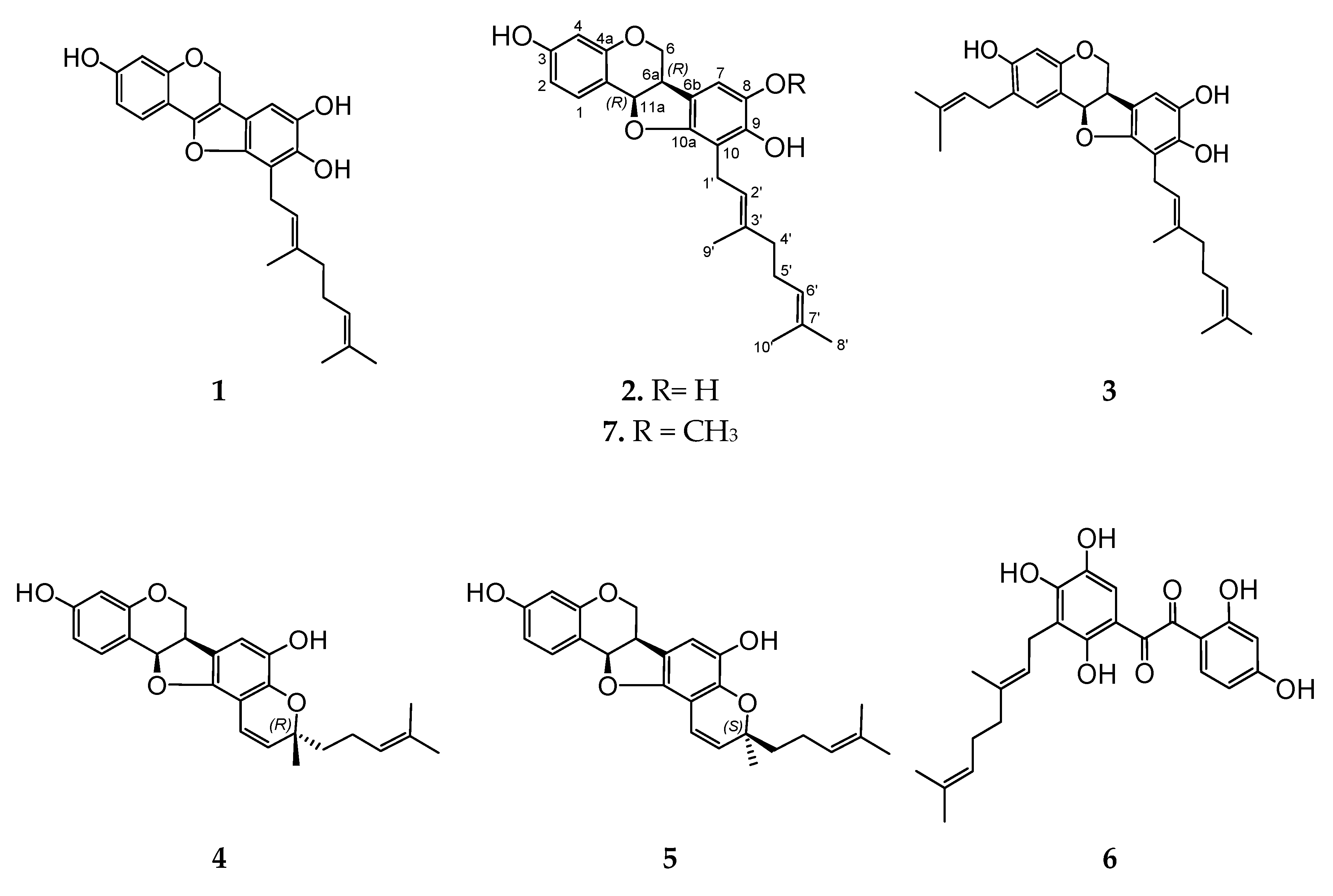
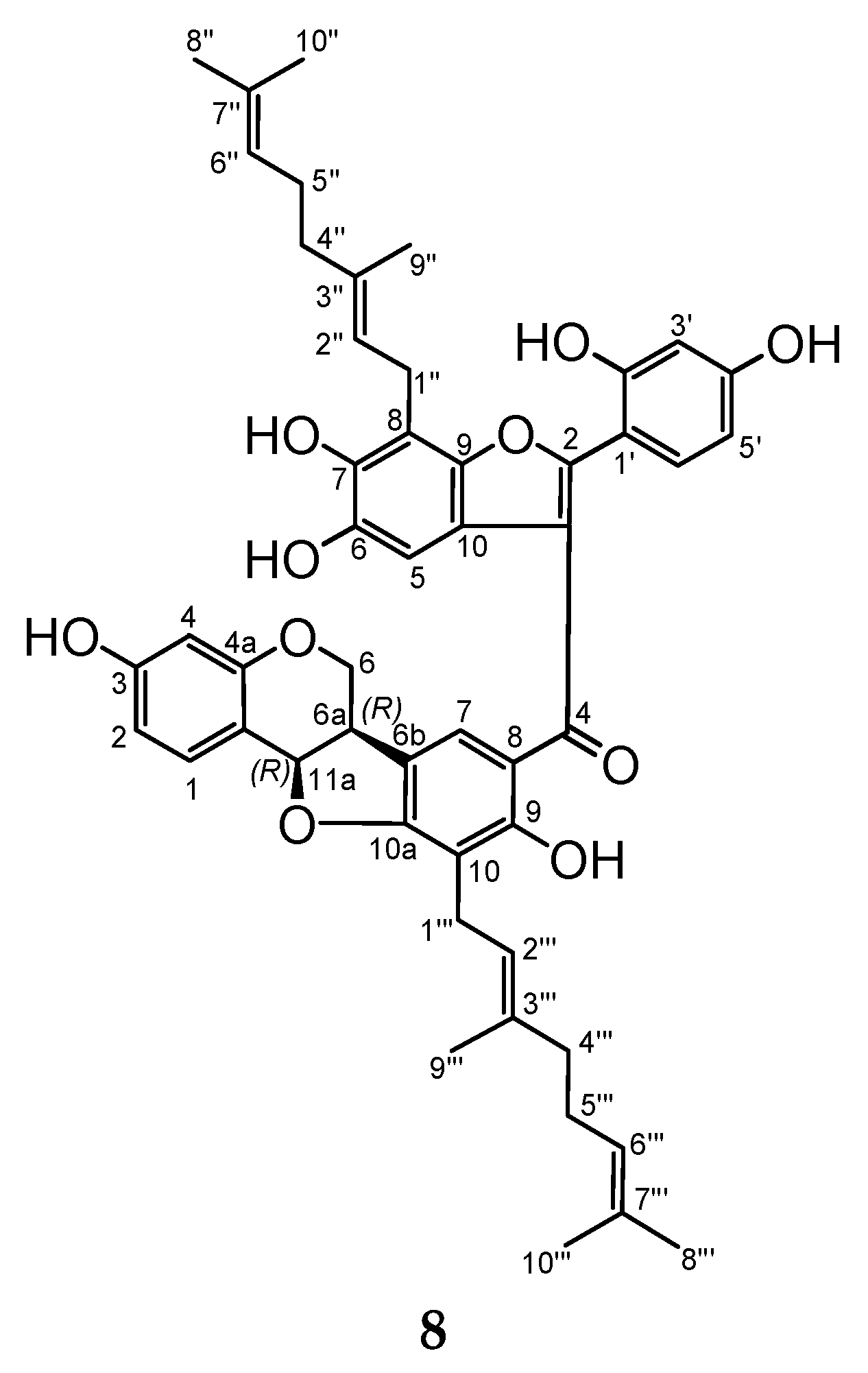


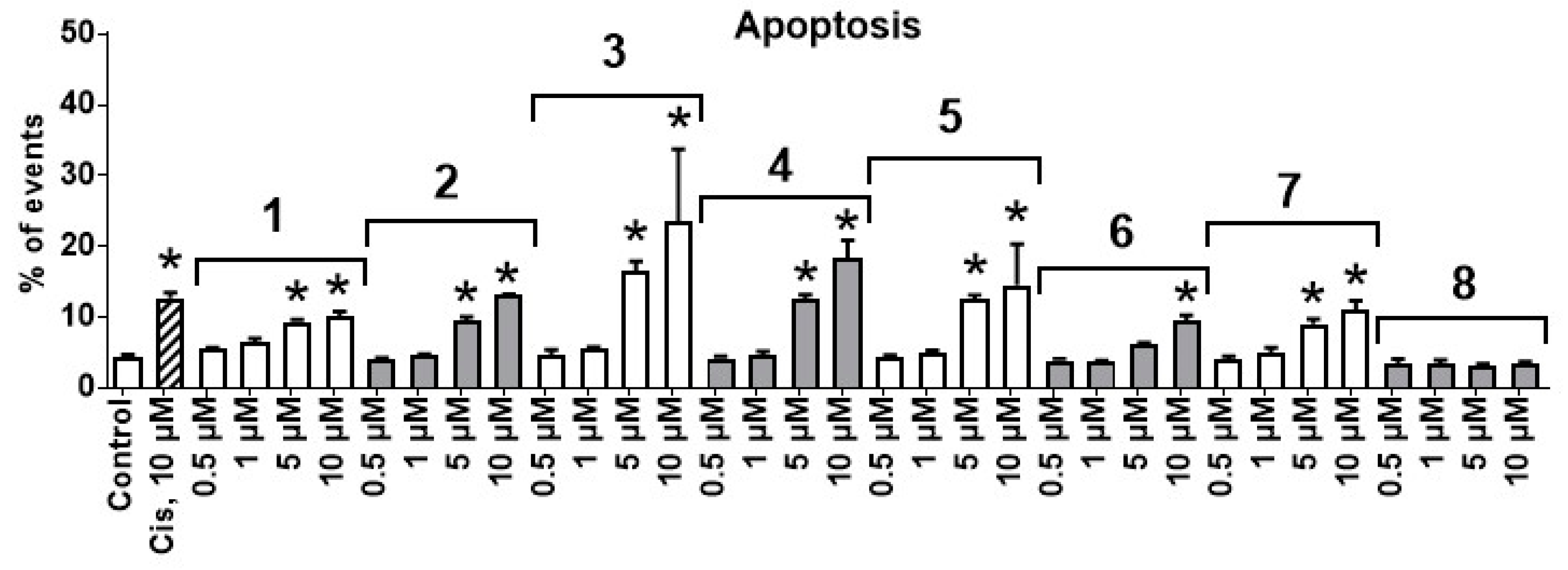
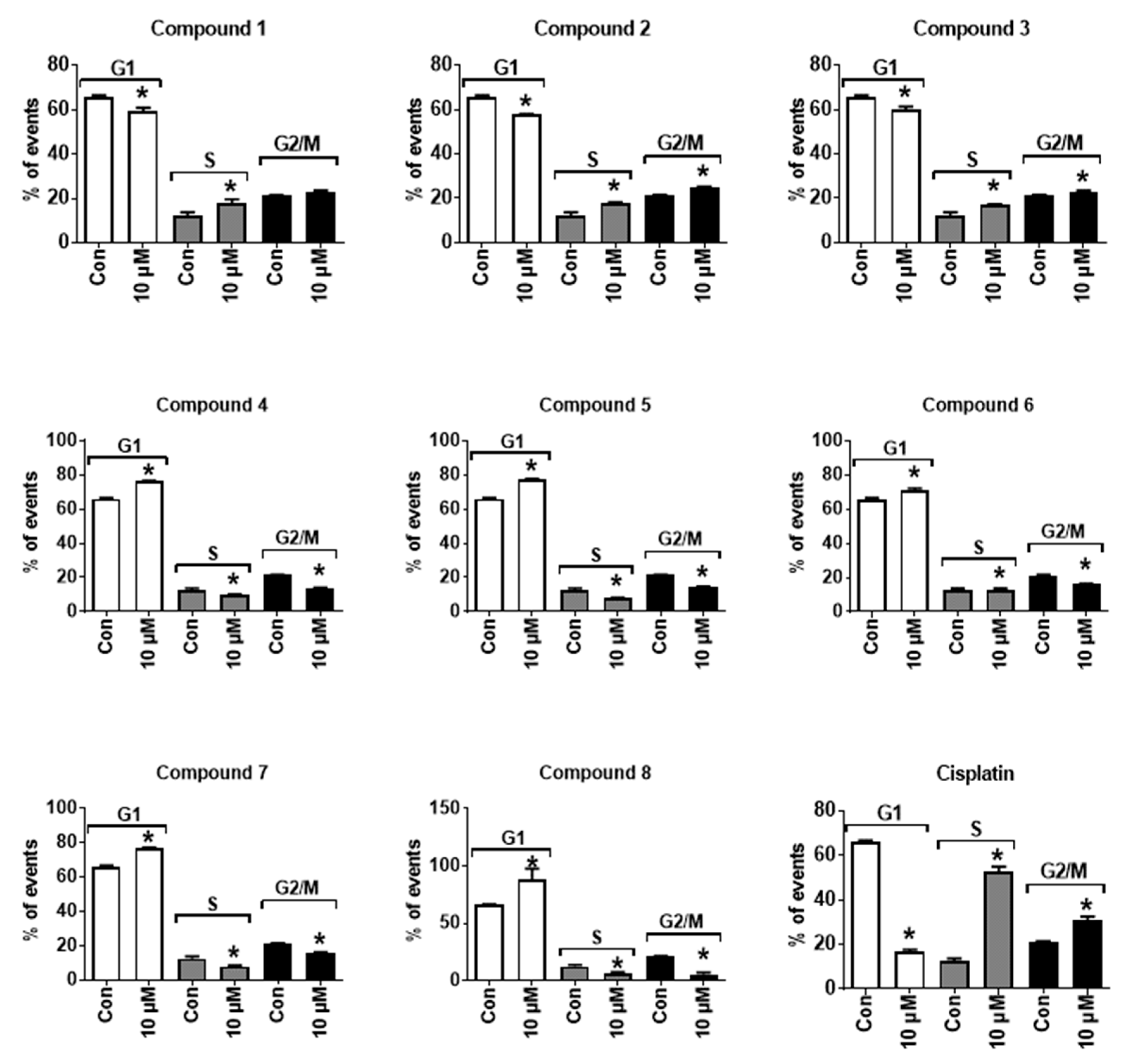
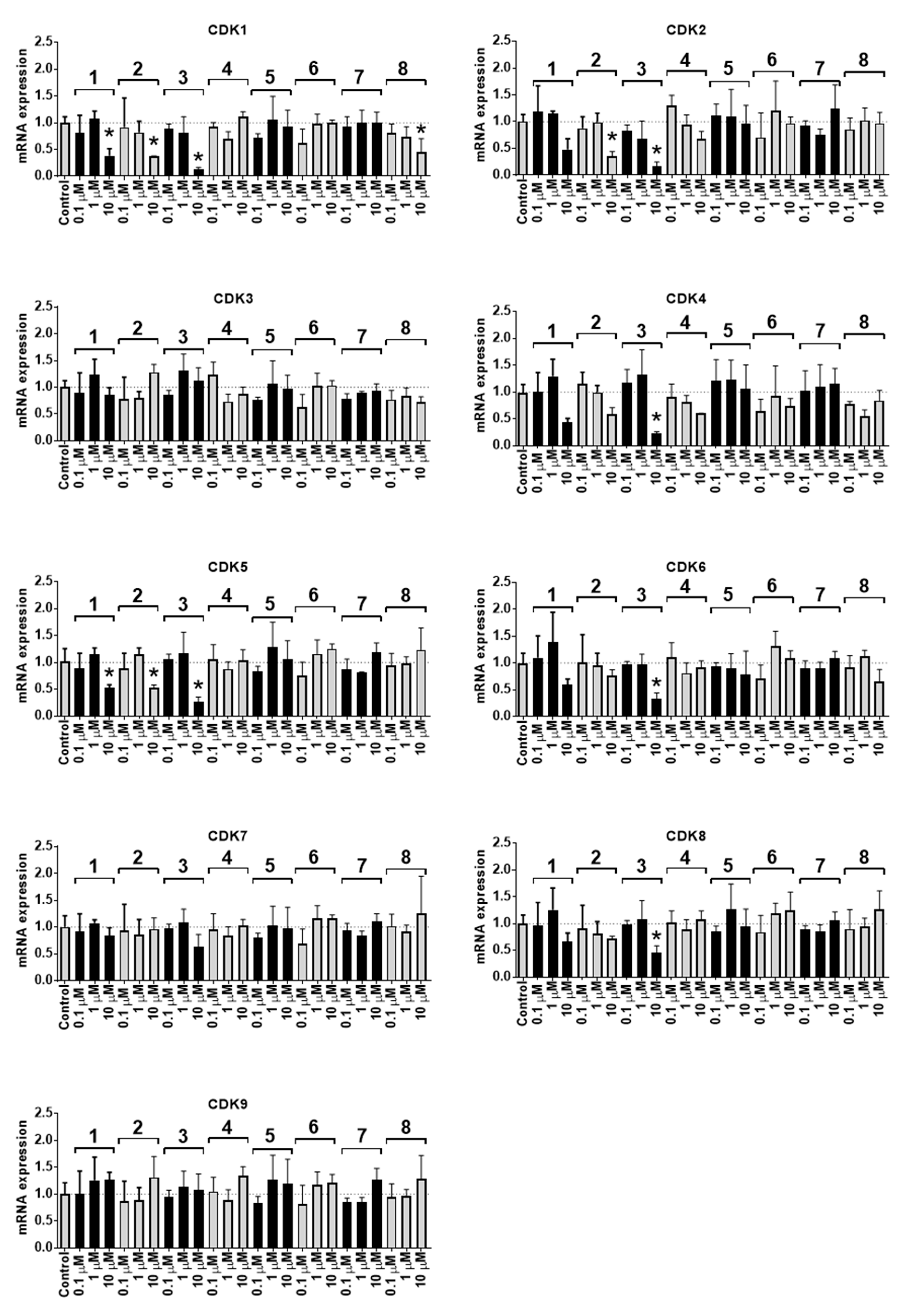
| N | δH (J in Hz) | δC | HMBC | ROESY |
|---|---|---|---|---|
| 1 | 7.40 d (8.4), 1H | 132.4 | C-3, 4, 4a | 2 |
| 2 | 6.55dd (2.6, 8.4), 1H | 109.5 | C-3, 4, 11b | 1 |
| 3 | 156.7 | |||
| 4 | 6.40 dd (2.6), 1H | 103.5 | C-2, 3, 4a, 11b | |
| 4a | 156.6 | |||
| 6 | 4.22 dd (5.0, 11,0), 1H | 66.6 | C-4a, 6a, 6b, 11a | 6, 6a, 7 |
| 3.66 t (11.0), 1H | 66.6 | C-4a, 6a, 6b, 11a | 6 | |
| 6a | 3.48 m, 1H | 40.7 | C-6, 6b, 10a | 6, 11a |
| 6b | 115.6 | |||
| 7 | 6.66 s, 1H | 105.1 | C-6, 6a, 6b, 8, 9, 10, 10a | 6, OCH3-8 |
| 8 | 141.0 | |||
| 9 | 144.5 | |||
| 10 | 111.8 | |||
| 10a | 152.4 | |||
| 11a | 5.40 d (7.0), 1H | 77.4 | C-1, 4a, 6, 6a, 6b, 11b | 6a |
| 11b | 113.3 | |||
| 1’ | 3.32 m, 2H | 23.0 | C-8, 9, 10, 2’, 3’ | 2’, 9’ |
| 2’ | 5.30 t (7.2), 1H | 121.5 | C-10, 1’, 4’, 9’ | 1’, 4’ |
| 3’ | 135.6 | |||
| 4’ | 1,96 m, 2H | 39.8 | C-2’, 3’, 5’, 6’, 9’ | 2’, 6’ |
| 5’ | 2.04 m (8.3, 7.4, 7.2), 2H | 26.7 | C-3’, 4’, 6’, 7’ | 6’ |
| 6’ | 5.07 t (6.8), 1H | 124.4 | C-5’, 8’, 10’ | 4’, 5’ |
| 7’ | 131.1 | |||
| 8’ | 1.64 s, 3H | 25.6 | C-6’, 7’, 10’ | |
| 9’ | 1.76 s, 3H | 16.1 | C-2’, 3’, 4’ | 1’ |
| 10’ | 1.56 s, 3H | 17.6 | C-6’, 7’, 8 | |
| OH-3 | 4.78 bs, 1H | |||
| OCH3-8 | 3.85, 3H | 56.9 | C-8 | 7 |
| OH-9 | 5.69 s, 1H | C-8, 9, 10, 10ª |
| N | δH (J in Hz) | δC | HMBC |
|---|---|---|---|
| Upper | |||
| 2 | 153.7 | ||
| 3 | 119.5 | ||
| 4 | 194.6 | ||
| 5 | 6.82 s, 1H | 103.4 | C-6, 7, 8, 9, 10 |
| 6 | 141.5 | ||
| 7 | 147.3 | ||
| 8 | 111.0 | ||
| 9 | 141.9 | ||
| 10 | 116.9 | ||
| 1’ | 110.7 | ||
| 2’ | 156.6 | ||
| 3’ | 6.50 d (2.3), 1H | 105.0 | C-1’, 2’, 4’, 5’ |
| 4’ | 158.6 | ||
| 5’ | 6.41 dd (2.3, 8.5), 1H | 108.6 | C-1’, 3’ |
| 6’ | 7.26 d (8.5), 1H | 132.2 | C-2, 2’, 4’ |
| 1″ | 3.69 d (7.3), 2H | 23.4 | C-7, 8, 9, 2″, 3″ |
| 2″ | 5.42 t (7.3), 1H | 120.4 | C-4″, 9″ |
| 3″ | 139.3 | ||
| 4″ | 2.11 m, 2H | 39.7 | C-2″, 3″, 5″, 6″, 9″ |
| 5″ | 2.13 m, 2H | 26.4 | C-4″, 6″, 7″ |
| 6″ | 5.07 m, 1H | 123.8 | |
| 7″ | 132.1 | ||
| 8″ | 1.68 s, 3H | 25.7 | C-6″, 7″, 10″ |
| 9″ | 1.86 s, 3H | 16.3 | C-2″, 3″, 4″ |
| 10″ | 1.60 s, 3H | 17.7 | C-6″, 7″, 8″ |
| Lower | |||
| 1 | 7.38 d (8.5), 1H | 132.4 | C-3, 4a,11a |
| 2 | 6.56 dd (2.4, 8.5), 1H | 110.1 | C-4, 11b |
| 3 | 157.2 | ||
| 4 | 6.38 d (2.4), 1H | 103.6 | C-2, 3, 4a, 11b |
| 4a | 156.4 | ||
| 6 | 4.01 m, 1H | 66.3 | |
| 3.56 m, 1H | 66.3 | ||
| 6a | 3.46 m, 1H | 39.6 | |
| 6b | 118.4 | ||
| 7 | 7.34 s, 1H | 127.1 | C-4 (upper), 6a, 9, 10a |
| 8 | 113.4 | ||
| 9 | 164.8 | ||
| 10 | 112.3 | ||
| 10a | 164.8 | ||
| 11a | 5.58 d (7.3), 1H | 79.2 | C-1, 4a, 6, 11b |
| 11b | 112.5 | ||
| 1‴ | 3.32 d (7.2), 2H | 22.2 | C-9, 10, 10a, 2‴, 3‴ |
| 2‴ | 5.26 t (7.2), 1H | 121.0 | C-10, 1‴, 4‴, 9‴ |
| 3‴ | 136.0 | ||
| 4‴ | 1.98 m, 2H | 39.8 | C-2‴, 3‴, 5‴, 6‴, 9‴ |
| 5‴ | 2.04 m, 2H | 29.7 | C-3‴, 4‴, 6‴, 7‴ |
| 6‴ | 5.07 m, 1H | 124.4 | C-8‴, 10‴ |
| 7‴ | 131.3 | ||
| 8‴ | 1.64 s, 3H | 25.6 | C-6‴, 7‴, 10‴ |
| 9‴ | 1.77 s, 3H | 16.2 | C-2‴, 3‴, 4‴ |
| 10‴ | 1.56 s, 3H | 17.6 | C-6‴, 7‴, 8‴ |
| OH-9 | 12.83, s, 1H | ||
| Primer | Sequence | Tm [°C] |
|---|---|---|
| CDK1_for | ACAGGTCAAGTGGTAGCCATGA | 60 |
| CDK1_rev | ACCTGGAATCCTGCATAAGCA | |
| CDK2_for | TTCTCATCGGGTCCTCCACC | 61 |
| CDK2_rev | TCGGTACCACAGGGTCACCA | |
| CDK4_for | CTGTGCCACATCCCGAACTG | 61 |
| CDK4_rev | GCCTCTTAGAAACTGGCGCA | |
| CDK5_for | CCACAACATCCCTGGTGAACGT | 62 |
| CDK5_rev | CCTCTTCTGCTGAGATACGCTG | |
| CDK6_for | CCGAAGTCTTGCTCCAGTCC | 61 |
| CDK6_rev | GGGAGTCCAATCACGTCCAA | |
| CDK7_for | TCACATCTTCAGTGCAGCAGG | 59 |
| CDK7_rev | TGGCAGCTGACATCCAGGT | |
| CDK8_for | AGCGGGTCGAGGACCTGTTT | 62 |
| CDK8_rev | CATGCCGACATAGAGATCCCAG | |
| CDK3_for | TCGCTGCTCAAGGAACTGAAGC | 62 |
| CDK3_rev | GTCCTGGCTGAGGAACTCAAAC | |
| CDK9_for | CCATTACAGCCTTGCGGGAGAT | 62 |
| CDK9_rev | CAGCAAGGTCATGCTCGCAGAA |
| IC50, µM | ||||||||||
| Compound | 1 | 2 | 3 | 4 | 5 | 6 | 7 | 8 | Cisplatin | |
| Cell line | PC-3 | 6.73 | 5.24 | 2.1 | 16.37 | 15.23 | 19.26 | 14.86 | 9.24 | 21.0 |
| 22Rv1 | 20.14 | 13.85 | 6.38 | 29.53 | 35.81 | 46.9 | 30.51 | 17.51 | 4.53 | |
| MRC-9 | 48.51 | 37.57 | 16.82 | 27.18 | 24.61 | >50 | 24.4 | 23.95 | 15.12 | |
| Selectivity index (MRC-9 vs. PC-3) | 7.21 | 7.17 | 7.99 | 1.66 | 1.62 | >2.6 | 1.64 | 2.59 | 0.72 | |
© 2020 by the authors. Licensee MDPI, Basel, Switzerland. This article is an open access article distributed under the terms and conditions of the Creative Commons Attribution (CC BY) license (http://creativecommons.org/licenses/by/4.0/).
Share and Cite
Dyshlovoy, S.A.; Tarbeeva, D.; Fedoreyev, S.; Busenbender, T.; Kaune, M.; Veselova, M.; Kalinovskiy, A.; Hauschild, J.; Grigorchuk, V.; Kim, N.; et al. Polyphenolic Compounds from Lespedeza Bicolor Root Bark Inhibit Progression of Human Prostate Cancer Cells via Induction of Apoptosis and Cell Cycle Arrest. Biomolecules 2020, 10, 451. https://doi.org/10.3390/biom10030451
Dyshlovoy SA, Tarbeeva D, Fedoreyev S, Busenbender T, Kaune M, Veselova M, Kalinovskiy A, Hauschild J, Grigorchuk V, Kim N, et al. Polyphenolic Compounds from Lespedeza Bicolor Root Bark Inhibit Progression of Human Prostate Cancer Cells via Induction of Apoptosis and Cell Cycle Arrest. Biomolecules. 2020; 10(3):451. https://doi.org/10.3390/biom10030451
Chicago/Turabian StyleDyshlovoy, Sergey A., Darya Tarbeeva, Sergey Fedoreyev, Tobias Busenbender, Moritz Kaune, Marina Veselova, Anatoliy Kalinovskiy, Jessica Hauschild, Valeria Grigorchuk, Natalya Kim, and et al. 2020. "Polyphenolic Compounds from Lespedeza Bicolor Root Bark Inhibit Progression of Human Prostate Cancer Cells via Induction of Apoptosis and Cell Cycle Arrest" Biomolecules 10, no. 3: 451. https://doi.org/10.3390/biom10030451
APA StyleDyshlovoy, S. A., Tarbeeva, D., Fedoreyev, S., Busenbender, T., Kaune, M., Veselova, M., Kalinovskiy, A., Hauschild, J., Grigorchuk, V., Kim, N., Bokemeyer, C., Graefen, M., Gorovoy, P., & von Amsberg, G. (2020). Polyphenolic Compounds from Lespedeza Bicolor Root Bark Inhibit Progression of Human Prostate Cancer Cells via Induction of Apoptosis and Cell Cycle Arrest. Biomolecules, 10(3), 451. https://doi.org/10.3390/biom10030451






